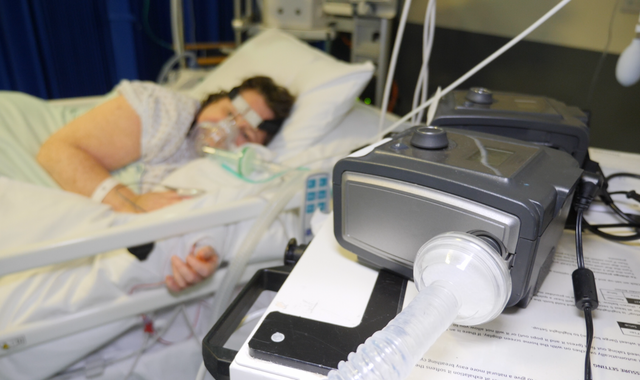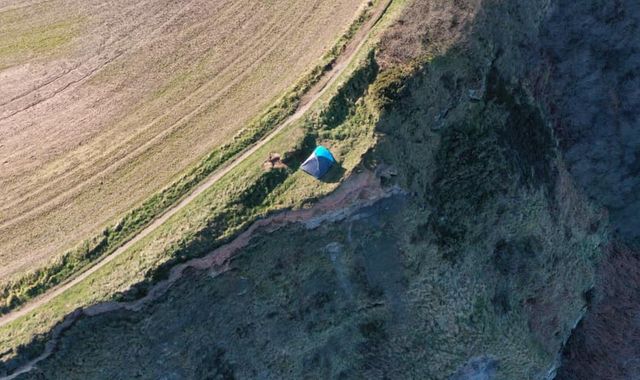Coronavirus: Hospital cuts COVID-19 death rates with ‘black boxes’ for sleep disorder
Written by News on 24/04/2020
Medics fighting COVID-19 in a hospital in Cheshire seem to have cut mortality rates and improved the chances of a quick recovery from the virus by adapting breathing machines normally used for a sleeping disorder.


Doctors at Warrington Hospital have modified devices known as “black boxes” which usually treat sleep apnoea – a condition which means breathing stops and starts while sleeping.
The clinicians say by treating COVID-19 patients early with their “black boxes”, it has meant there has been less need for the more intrusive and invasive ventilators and they’ve experienced a far quicker recovery rate.
One of the hospital’s consultants said they had started from “ground zero” in how to manage the pandemic in the area.
Dr Mark Forrest told Sky News: “We watched very closely what was happening in other countries, in particular Italy, and learned from them.”
He said their small team of seven consultants and their respiratory colleagues quickly realised the ventilators were not the “magic bullet solution” to COVID-19.
The hospital normally has access to only 12 ITU (intensive therapy unit) ventilators.
But they re-serviced an additional five from an older generation, plus recommissioned seven more from their critical care transport equipment, as well as utilising their anaesthetic machines.
Even with all these extra ventilating devices, with so many patients presenting with respiratory problems, they were still not going to be sufficient if the hospital had to depend on ventilators as the main form of treatment.
At the same time, they realised using ventilators – which require a breathing pipe to be inserted down the throat and the patient to be put under anaesthetic – had a relatively poor recovery rate. In some cases it was only 50-50.
This realisation was in line with medics across the world who were also finding it was a long and difficult journey to bring COVID-19 patients back to recovery from ventilation – and a journey which often didn’t result in survival.
The team made an early decision to try to avoid ventilation by switching to CPAP machines (continuous positive airway pressure) where the device pumps oxygen, under a constant pressure, into the lungs through a close-fitted face mask.
The device keeps the airways continuously open in those patients who are able to breathe on their own but it stops their lungs from collapsing.
But again, like many hospitals across the country and the world, the hospital only had a limited number in stock. In Warrington’s case, they had six.
They’d heard of reports that engineering teams from Mercedes Formula One and doctors at University College London Hospital were attempting to upgrade existing CPAP devices to meet the need for COVID-19 patients.
“But this seemed months away and we needed the machines now,” said Dr Forrest.
A spokesman for UCL said around 10,000 machines have been manufactured and are already being distributed to NHS hospitals.
NHS healthcare professionals can request the devices for their hospitals at no cost.
:: Listen to the Daily podcast on Apple Podcasts, Google Podcasts, Spotify, Spreaker
A team in the hospital’s respiratory department led by Dr Mithun Murthy, alongside consultant Saagar J Patel, realised the simple black boxes they used in their sleeping disorder clinic were built on the same premise as the much more sophisticated and expensive CPAP machine.
Dr Murthy said he believed the adaption of the simple device had probably been responsible for changing the lives and the medical outcome for hundreds of COVID-19 patients who’d passed through Warrington Hospital.
The boxes, which are considerably cheaper than the hospital versions, are simple enough for patients to use at home at night for typically a maximum of 12 hours.
But the medics in the hospital’s intensive care unit (ICU) found by putting patients on the black boxes as soon as they arrived in the department, they stabilised quickly, avoiding ventilation.
“Often we were seeing positive reaction within 15 minutes,” said Dr Forrest.
The respiratory team at the hospital, working in close collaboration with their ICU colleagues, modified the boxes by fitting them with superior masks and linking them up to oxygen.
They first tested it on fellow members of staff before trying it on patients. “We really believed it would work. It was a case of having it confirmed,” said Dr Murthy.
We spoke to Donna Wall, a mother of two in ICU who was attached to one of the black boxes. The clinicians had set up a second black box close by for the ICU staff to use in tandem.
“I feel so much better,” she told us. “I started feeling better almost straight away. I don’t want to be a statistic. I want to go back home to my two children.”
We saw a couple who’d both contracted coronavirus reunited for the first time after recovery.
Harold and Christine Thomson were both taken to hospital by ambulance on Saturday unable to breathe.
Mr Thomson, 64, was admitted straight to ICU.
“I really thought I wouldn’t be going home,” he told Sky News.
His wife’s eyes filled with tears at the memory. “I said goodbye to him and I wasn’t sure if I’d ever see him again,” she said.
Mr Thomson was fitted with the modified CPAP black box in ICU and five days later is now fit enough for the two of them to go home.
“The staff have been incredible,” he said. “I hope now the government sees the worth of the NHS and realise that if they hadn’t cut services so much, we would have been better prepared.”
(c) Sky News 2020: Coronavirus: Hospital cuts COVID-19 death rates with ‘black boxes’ for sleep disorder







